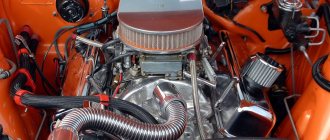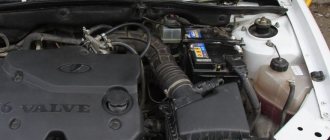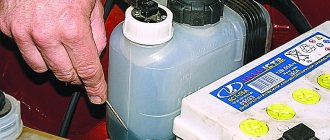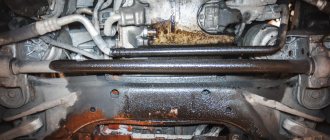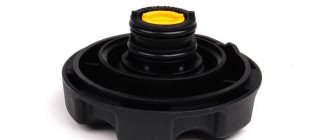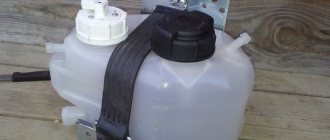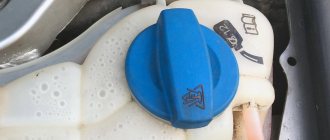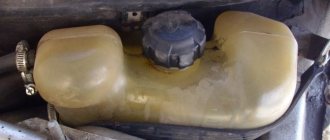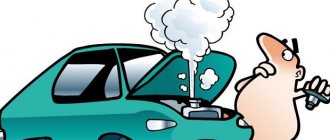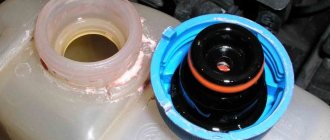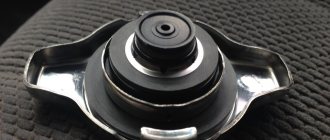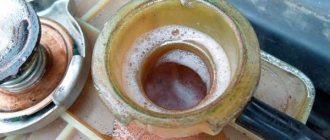- home
- Coolant
- …
In the previous article about replacing the coolant (after what mileage), you can see it here . Under the video, I was asked the following question: “ My antifreeze level in the expansion tank periodically drops, and nothing is leaking anywhere, everything is fine (checked at a service station). But periodically I add antifreeze to the level? "Is this normal or not? Can it evaporate? How does this happen, since the system seems to be sealed? These are very common questions that confuse especially beginners, because if the fluid drops below a certain level, the engine can overheat. Today I will reveal these questions, and of course the video version is below...
At the very beginning, I would like to say that I already have an article about breakdowns in the cooling system , when the antifreeze does not evaporate, but leaves! Let's say through pipes, connections, hoses, radiators, etc. Read it before this material, you may have leaks. Today we will talk specifically about evaporation, and on which cars is this relevant?
Composition of antifreeze (TOSOLA)
I’ve already written about this many times, but it’s worth repeating here for understanding:
The largest component is distilled water , then comes ethylene glycol or propylene glycol (modern coolants may also contain glycerin) + additives and dyes (the least of them)
As you and I understand, the main component is water, and as we know from physics, it simply evaporates. In the morning there was a puddle (the sun was shining), after a couple of hours there was no puddle
Likewise, from antifreeze, water can evaporate, and accordingly the level drops, and the hotter and drier the weather, the more the level goes. No miracles, just physics
BUT this is if you leave the antifreeze open, say in the sun.
Closed expansion tank
Another unclear question is how does antifreeze evaporate, since the expansion tank is closed? No, of course there is access to the cooling system; there is a special cover. But we don’t unscrew it when we drive?
And here everything is quite simple. Often the lid has two valves - low and high pressure.
When the car warms up, the coolant also warms up and its volume increases. To prevent the system from rupturing, manufacturers make a high-pressure valve (usually it is built into the lid), at indicators of, say, 1.1 - 1.4 ATM (different manufacturers have different values), it opens and relieves excess pressure. The system becomes stable
It is with this “opening” that part of the water comes out. It may be small, but the lid can be opened many times.
Of course, then, say at night, when the engine cools down, the pressure in the system also begins to drop, and now in the other direction, it becomes extremely low, the hoses begin to narrow. Again, to avoid damage, the valve cover opens, only to begin to suck in air from the environment.
By the way, if it is wet, then the level of antifreeze in the cooling system may even increase.
Permissible amount of water in the cooling system
Antifreeze can be diluted with distilled water in a ratio of 1 to 1. This means that the car will start without problems in temperatures down to -25 degrees. If in summer 100-200 ml was added. water, this will not have any effect on the ability of the engine to start in cold weather.
But if you add 500 ml of water or more, starting the engine will be difficult even at -15 degrees. In regions where the winter is long and frosty, you should not add distilled water to the expansion tank again; it is better to immediately change the technical fluid. Choose high-quality, reliable and proven antifreeze for your car.
Stay up to date with our news
— subscribe to official channels on social networks:
Source
Various engines
I would also like to talk about different engines; not all cars have the same cooling, it depends on some parameters:
- From the block material . Some people use cast iron, others use aluminum. All this will greatly affect engine cooling and antifreeze evaporation. For example, an aluminum block warms up faster; because of this, the pressure in the system can be 1.1 or 1.4 ATM, and the high pressure valve opens more often. For a cast iron block, heating is slower, the parameters can be 0.9 - 1.0 ATM, ideally it loses liquid more slowly
- Channel system. It also greatly depends on how the engine warms up and how much temperature it removes.
- Amount of antifreeze. Some have more, some have less. The less, the more heating, the more pressure and valve openings
- Radiators. Again, modern ones have a small volume; they do not dissipate heat so effectively.
- Thermostat. There are so-called cold and hot ones. They have a different opening, the hot ones “wait” for the temperature to warm up for greater indicators than the cold ones. The evaporation of antifreeze also depends on this, although indirectly
So you can’t compare different cars, for example, one evaporates more, another doesn’t drop the level at all, you need to look at the design of a specific variant
Myth two. The main task is not to freeze at sub-zero temperatures
If you literally translate the word “antifreeze”, you get “anti-freeze” (from the Greek “against” and the English “to freeze”). Based on this, you can decide that the main and only task of the coolant is not to freeze at temperatures below zero. This is partly true, but there are nuances.
“In fact, the most important role of the coolant is to regulate the temperature in the system and prevent the engine from overheating,” experts say. — About a third of the energy obtained as a result of fuel combustion is dissipated through the radiator.
The following fact speaks about the conditions under which antifreeze has to work: the temperature of the parts in the piston group can reach +350 degrees Celsius.
Of course, the coolant should not freeze, but this is the third priority task - after regulating the temperature in the engine and preventing corrosion in the cooling system.
Various liquids
Now many manufacturers indicate this. The fact is that coolants do not stand still, but develop. If this is applied to VOLKSWAGEN, the evolution went from G11 to G13.
So, there is information that more advanced antifreezes evaporate less, because special additives are added to them. By the way, they boil at higher temperatures.
So if you are flooded with G11, or our antifreeze, there is a high probability that they will leak more than purple G13.
Myth one. You need to choose by color
The most common opinion is that when choosing antifreeze you should focus on the color of the finished liquid or concentrate. Most sellers at a market or in a specialized shopping center first ask: “Red? Then I can suggest the following manufacturers. » Onliner correspondents were convinced of this themselves during the purchase of control samples.
Experts are tired of convincing us that we can ignore the color of the coolant. We repeat once again: the dye is needed solely to identify leaks in the cooling system. Antifreeze manufacturers have long stopped marking product formulas using color. Moreover, some warn that the dye may degrade over time and this is normal.
Where did this misconception come from? The head of the technical development department (acting as a partner in the investigation), Evgeniy Ryazanov, has the following explanation: “The Volkswagen company, from which many manufacturers borrowed already familiar designations, really separated their products using color. The fluid labeled G11 was blue, G12 was red, and G13 was purple. This is not relevant for antifreeze from other manufacturers ."
How to add antifreeze correctly?
If your level has dropped, then it needs to be replenished. And it seemed like a simple question - I bought the same one and poured it . But many begin to make a tragedy out of this and write that you cannot pour antifreeze, but only distilled water! But is it?
I wouldn't pour distilled water!
- If you have a hot country, then you can dilute it with water . But if you have a cold country, you lower the lower threshold. It’s commonplace that it will freeze at -20, -25 degrees. But if you add the same antifreeze, the freezing threshold will simply remain at the same level
- You also lower the upper threshold . Many ready-made antifreezes can boil at atmospheric pressure at + 105, +110 degrees. When you add water, these values will drop
- Reduce the protective properties of additives . Thus, the cooling system (including pumps, thermostats, etc.) will deteriorate faster.
- Lubrication . Whatever one may say, antifreeze is a little oily, so, albeit a little, it lubricates the pump, thermostat and other parts of the system. If you dilute it with water, these properties will simply decrease
So, pour the same brand of antifreeze that the manufacturer specifies for you, or the one you poured yourself when replacing.
Now let's watch the video version
This is where I end, I think you liked my materials. Go ahead and read others on my site, and I will end sincerely yours AUTOBLOGGER
Similar news
- Do-it-yourself anti-rain. A powerful recipe for a car
- Is it possible to mix antifreeze and antifreeze (red, green, blue). TO…
- Anti-fog for car windows. DIY recipe
What is better to add to the cooling system - water or antifreeze? I didn't know it before
Especially during hot periods, those car owners who love their car constantly ensure that the fluid levels are within normal limits.
Each of you knows that over time the antifreeze level drops. It contains water, and it inevitably evaporates from the system.
Every self-respecting motorist is faced with the need to add distilled water or antifreeze to the cooling system. Let's figure out what's best to add.
If you know what is in your cooling system, then it will not be difficult to buy the same coolant and add it. If you don't know this, then what should you do?
In this case, I recommend simply adding distilled water. Many drivers say that different antifreezes can be mixed without problems, there will be no problems at all.
They even conduct experiments, show how different antifreezes are mixed, and nothing happens.
But they do not show how this mixture will behave in the future. They may have different compositions, so I do not recommend taking risks. In this case, it is better to simply add distilled water. Why is this so?
Any antifreeze and antifreeze is made based on distilled water. There is no way you can harm the coolant if you add 100-200 ml of water. Typically, water has the highest volatility. Of course, ethylene glycol and propylene glycol partially evaporate. But most of all, water evaporates.
After this, the concentration of antifreeze in the system increases. When you add distilled water, you are not doing anything wrong. You simply return the density of the mixture to normal, unless, of course, there is a leak from the cooling system.
I still do this to this day and have never had any problems. In case of a leak, you cannot add water, as the concentration of antifreeze will decrease and it may freeze in winter.
If you know what was filled and what brand of fluid was used before, then purchase the required volume and add it to the cooling system. Then everything will be fine.
But under no circumstances should you use another antifreeze, even one that is similar in color. They may be different in composition, and this can cause contamination of the cooling system.
Source
